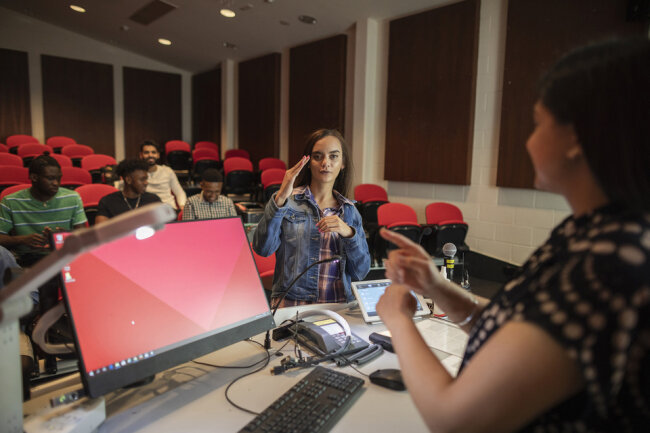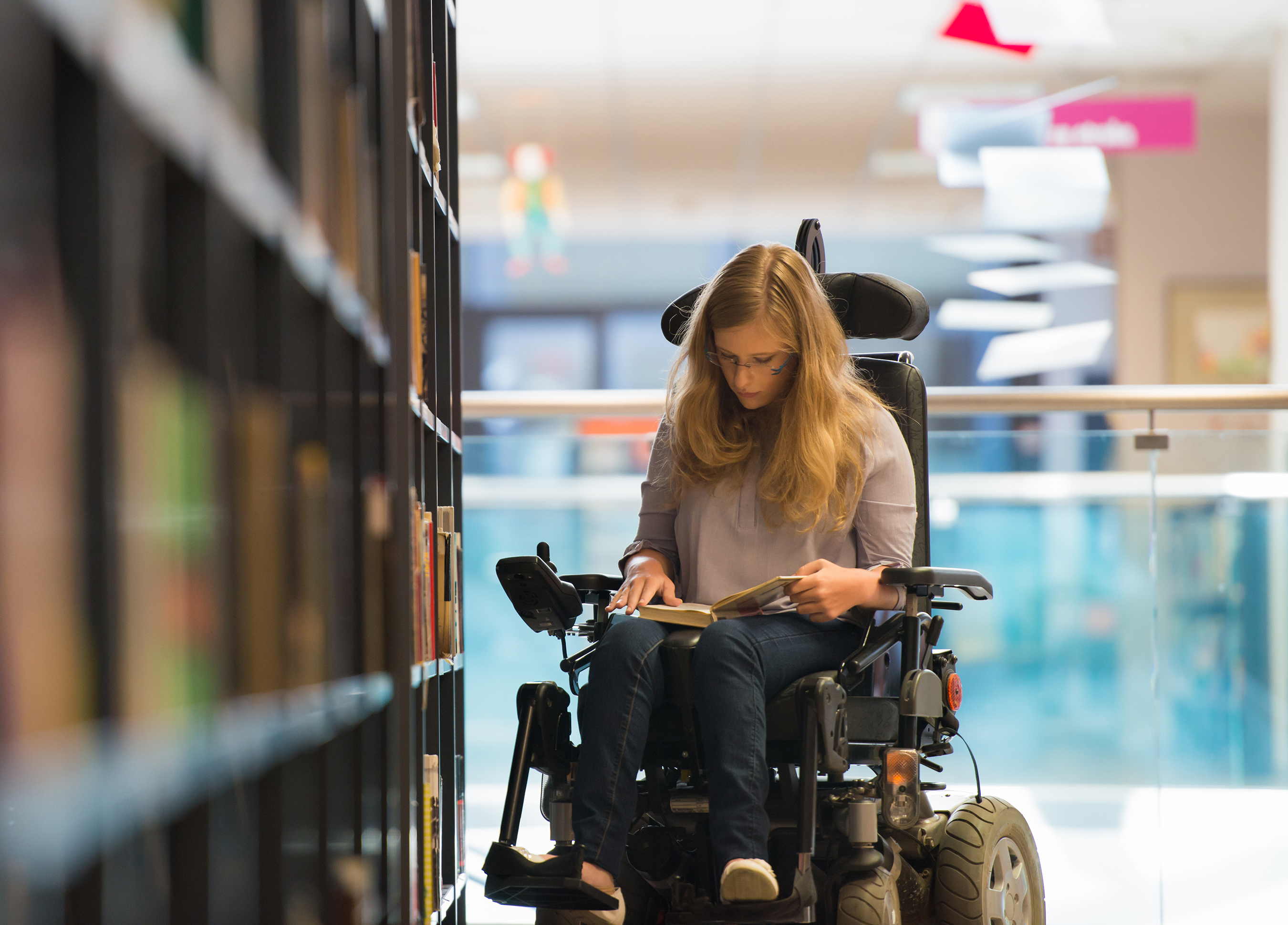
Welcome to the second post in our blog series on the Americans with Disabilities Act (ADA) and its intersection with the AV industry.
In the previous blog post, we covered many of the physical requirements of an AV space to meet ADA compliance. For this post, we’re going to get some first-hand knowledge about accessibility and why it’s so important. Then, we will provide a brief overview of the basics. This includes explaining what the ADA is, its scope, and the benefits of incorporating ADA principles into design. By considering the ADA, we can enhance the experience for everyone involved.
We’ll even throw in a “Why is Legrand | AV doing this?” for you along the way.
Consider this blog series a companion piece to Legrand | AV’s publication “ADA in AV Making AV Technology ADA compliant.” The guide is the most comprehensive publication specifically for the AV industry about the ADA that we know of. Visit www.legrand.com/ada to find the guide and other free resources on this topic.
The Impact of Accessibility
For 20 years, the ADA and AV have been a large part of life for Dan O’Donnell, Director of Outside Sales at Starin. He's worked in tech his entire career. At the same time, he and his wife have three children. His oldest, Matthew, Mattie for short, was born with quadriplegic cerebral palsy.
“So he’s in a wheelchair, he is nonverbal, but this kid is full of life! Cognitively, he’s there. He laughs at all the silly things that I do,” said O’Donnell.
Since first meeting with the Chief of Neurology at one of the most recognized children’s hospitals in the world, O’Donnell's had a front row seat for discovering how technology advancements have allowed Mattie to exceed all initial expectations. They were told Mattie would never walk – they found a device called KidWalk. They were told he would never talk – they found a device called My Tobii Dynavox.
“Overall accessibility continues to improve, but what’s really special is how AV can really kick that up a notch in a lot of different applications,” O’Donnell said.
An expanded understanding of all the possible users of a room, both now and in the future, is the only way to be able to determine how overall accessibility can improve. Cable retractors are a great example. A 30-foot HDMI cable coiled up in the corner of the room makes a space unwelcoming to someone who can’t reach down to connect it to their device. Using a cable retractor for connectivity at the conference table creates equity for anyone wanting to share content from their device.
Unfortunately, such solutions can be the first cut when budgets are overwhelmed with interior design choices. Overcoming this obstacle is familiar territory to AV professionals like O’Donnell.
“A lot of times in AV we hear ‘that’s not the way we used to do it,’” he said. “But what happens when life throws you that curve ball, and how can we take the products that we have today and make them accessible?”
O’Donnell is a big fan of iPads and how they’ve improved over the years to include eye gaze and dwell to help with a host of speech impairments.
“How cool would that be if you’re in a room and you see ‘One touch to join’ – what about ‘One look to join’ and be able to help provide that accessibility and have the room function?” O’Donnell said. “I would encourage people to think a little bit deeper behind the ones and zeros. What’s the user experience around the tech that we’re putting into these spaces?”

You can listen to the full interview with Dan O'Donnell at The Download Podcast.
One way to improve the user experience is to find ways to add accessibility to a space that is fully integrated. Much like hidden speakers, accessibility can be designed into a system without drawing attention to itself and creating a spotlight effect on the user who needs it to participate.
Walt Disney World Resort is an example of this experience working in real life. During a visit to EPCOT before they started renovations, an immersive experience showed visitors through projection mapping and audio what they could expect once construction was done.
“My son’s face, he just lit up,” O’Donnell said. “I know not every budget and every project has Disney money, but there are ways that we can make those subtle improvements to be able to deliver those experiences.”
You can hear more from Dan O’Donnell and his experiences on The Download Podcast. For now, let’s pull back for a wider view of the ADA.

What is the ADA?
The Americans with Disabilities Act was signed into law over 30 years ago on July 26, 1990, and updated in 2008, to ensure the provision of equal opportunities for individuals with disabilities. The ADA prohibits discrimination on the basis of disability just like other civil rights laws prohibit discrimination on the basis of race, color, sex, national origin, age and religion. The ADA is what ensures people with disabilities are given the same opportunities for employment, buying goods and services, and participating in civic life.
The ADA covers a wide range of disabilities, some listed, some not, some of which are visible and some of which are not. Roughly 26% of adults, or 13% of all age groups in the U.S. have some sort of disability according to the latest census. Some examples of disabilities are blindness or low vision, deafness or hearing loss, diabetes, cancer, mobility disabilities such as requiring a wheelchair or cane, major depressive disorders, and many, many more.
How Does AV Fit In?
For AV design purposes, we focus on ADA Title II (state and local government entities) and Title III (public accommodations and commercial facilities accessible and useable by individuals with disabilities). In the 2010 ADA Standards for Accessible Design, the government set minimum standards for all these spaces. The standards cover everything from washing machines to parking spots to miniature golf facilities, so it can be tricky to sift through to find specific standards that AV industry professionals should know.
At its most basic core, AV is about communication and connecting through the senses. Adding technology to spaces that help bridge the distance between people, no matter where they are, no matter who they are, is our top priority as AV professionals. Designing for the ADA simply expands that viewpoint with an awareness of the many ways we communicate.
By engaging more senses through AV, we reinforce messages and strengthen intelligibility. Building redundancies into the communication system with live captioning, interactive displays, and voice lift makes the experience accessible for everyone. Although ADA is the law, it’s just good business to assume all AV projects should address compliance.
Compliance comes in many forms since every state and region in the U.S. has its own specific regulations that come into play. Some places may even go further than the ADA requirements. This is why you should always defer to your regional office of the ADA National Network and local authority having jurisdictions.
Luckily, there are plenty of resources on all this and more listed in our guide. Download your free version at legrandav.com/ada.


Why is Legrand | AV Doing This?
At trade shows, we’re often asked if a solution complies with the ADA. More importantly, inclusion is a core piece of our corporate social responsibility mission, both in our hiring practices and our approach to AV design.
“Diversity of people creates diversity in thought and perspective for new approaches to problem solving and solution development,” said Tim Troast, VP – Technology & Product Strategy at Legrand | AV. “We strive to be a leading player in the area of diversity and inclusion, embracing and promoting all types of differences. That includes pursuing initiatives and developing resources to help us and the industry at large achieve equity of opportunity for people of any background and ability.”
We’re excited to get this resource out there to fully support our industry in creating amazing experiences through technology. Be sure to take a look at the next blog in this series, where we dial in on the right frequency when it comes to audio and the ADA.
This blog series is intended to be used for educational purposes only. The intent is to serve as a guide to ADA regulations pertaining to the installation and usage of audio visual technology. However, none of it shall be construed as legal advice, nor should you rely on this content without obtaining your own project-specific verification.
Those seeking additional details or legally accurate definitions of the ADA’s audio visual technology requirements should visit www.ada.gov.
ADA Blog Series Part 1
Let's Get Physical

ADA Blog Series Part 3
What's the Frequency AV?

ADA Blog Series Part 4
Real World Results

Explore ADA Resources

Get the ADA in AV eBook

Take ADA Courses at AV University

Learn More at the Podcast


